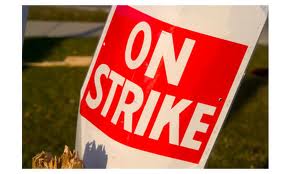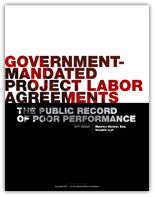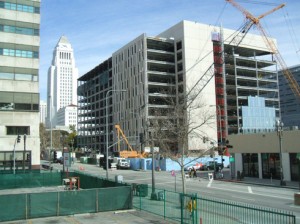Another PLA Myth Busted: PLAs Fail to Prevent Strikes on NYC Projects
Construction unions market project labor agreements (PLAs) to public and private construction owners as a tool to guarantee labor peace on construction projects.
But recent examples of strikes and walkouts on PLA projects in NYC and other areas across the U.S. call into question the value of these anti-competitive schemes designed steer contracts to union contractors and union members.
MYTH: PLAs Prevent Strikes.
Big Labor knows that strikes, work stoppages, slowdowns and other labor unrest caused by union bosses and rank and file members can shut down a jobsite and delay the opening of a project, potentially costing construction owners time and money and harming the project’s end-user. In fact, PLAs were originally developed in the 1930s as a solution to prevent costly strikes on important large-scale public works projects like dams during an era when more than 80 percent of the U.S. construction workforce belonged to a union.
Today, just 13.1 percent of the construction industry workforce belongs to a union, so union bosses leverage the threat of union-led strikes to acquire commitments from public and private owners to mandate PLAs in order to create more jobs for union members and increase the unionized sector’s dwindling market share.
Big Labor bosses load PLAs with terms and conditions favorable to union leaders, union members and unionized contractors hand-picked to receive preferential treatment by a PLA.
These agreements typically force contractors to hire all or most of their tradespeople from union hiring halls, pay into union pension and benefit plans, follow inefficient union work rules, and hire apprentices exclusively from union apprenticeship programs. As a condition of working on a PLA project, provisions in typical PLAs can also force nonunion employees to: (1) join a union or receive unwanted union representation; (2) follow archaic work rules; (3) pay union dues and initiation fees; and (4) forfeit any employer and employee contributions to union benefit plans unless they join a union and become vested in these plans.
Irrespective of whether a project is subject to a PLA mandate, the wage and benefit rates of tradespeople are usually already subject to government-determined prevailing wage rates that frequently mirror collectively-bargained rates contained in each specific trade union’s contract (which typically exceeds free market wage and benefit rates).
Any contractor is technically allowed to bid on a project subjected to a government-mandated PLA, but few nonunion contractors do. As last week’s Boston Herald editorial explains:
But in practical terms, they [PLAs] box out non-union companies (whose tradespeople are of course licensed by the state and must comply with all workplace safety rules), drive up public construction project costs and allow union-friendly politicians to curry favor with organized labor.
In short, government-mandated PLAs are schemes that help unions increase market share and deny qualified contractors and their skilled workforces a fair opportunity to bid and win taxpayer funded construction contracts.
PLA mandates cost taxpayers a bundle, needlessly limit competition, flirt with extortion and are particularly unsettling because nonunion workers – those that are effectively eliminated from PLA projects – don’t engage in strikes or jobsite unrest.
But the simple truth is that PLAs sometimes fail to prevent union strikes and labor unrest on PLA jobsites.
Yesterday Crain’s New York Business reported that a number of NYC jobsites were shut down and/or experienced strikes by concrete workers after “negotiations between Laborers’ Locals 6a, 18a and 20 of the Cement and Concrete Workers of New York and the Cement League broke down over demands by the industry association for wage cuts” (“Concrete workers walk off World Trade Center job,” 8/1/11):
“Workers are not supposed to strike at sites where developers and unions inked project labor agreements, but an industry source said concrete workers did not show up Monday for their jobs at the new Weill Cornell Medical Center research building on East 69th Street, a project that does have such an agreement. The source said a request for an arbitration hearing was made to the Building and Construction Trades Council.”
The Wall Street Journal reported that in addition to the Weill Cornell Medical Center, the Barclays Center at Atlantic Yards in Brooklyn – the new basketball arena for the NBA’s New York Nets – suffered a strike despite a PLA. (“Work Stoppage at WTC: Concrete Union Laborers Threaten Picket Line as Contract Negotiations Continue,” 8/1/11).
UPDATE: Crain’s reported that strikes violated a no-strike clause in PLAs covering the following PLA projects: Madison Square Garden, World Trade Center Tower 2 and Extell Development’s Carnegie 57 luxury hotel and hi-rise project across from Carnegie Hall on West 57th Street:
Here’s More from the WSJ on the cause of the strike:
More than two dozen union contracts expired in June. Most unions have since signed deals. In addition to cement workers, sheet metal workers still need to hammer out a new deal.
The cost of unionized labor has been a central theme in talks between contractors and the concrete workers, according to a person familiar with the matter.
Contractors want the concrete workers to accept 20% less in wages and benefits for residential construction work versus commercial work, the person said. The unions oppose that.
Concrete workers in New York earned $66.58 an hour in base pay and benefits last year, according to the Engineer New-Record, a trade publication.
“We can’t afford the strike [because of the economy], but we can’t afford to take a 20% pay cut,” said Mr. Montalbano, the concrete worker. “If it was up to me, we should freeze our wages until the economy gets better but don’t cut our wages.”
Earlier this year, NY building associations representing contractors signatory to union agreements with numerous trades did not attempt to cut wages and benefits in contract negotiations but instead asked for reforms to inefficient work rules contained in union agreements that increase costs and reduce productivity. They cited changes in work rules outlined in the Regional Plan Association report, Construction Labor Costs in New York City: A Moment of Opportunity, which found that “arcane union work rules, inefficient practices, and featherbedding impose 20 percent to 30 percent in excess costs, leading to dramatic increase in nonunion work on NYC construction sites.”
The study also mentioned that NYC developers complained that PLAs were a failure and delivered little to no promised cost savings:
“Management has been almost universally disappointed with the actual savings achieved—2 to 4 percent rather than the promised 20 percent.”
For years, even Big Labor bosses have admitted that a PLAs’ promise to prevent strikes and labor unrest is often broken, resulting in lost market share for union contractors.
For example, Joseph Hunt, the President of the Ironworkers Union, devoted his President’s Page column (“Ironworkers Have Tradition and Honor in Project Labor Agreements“) in the February 2008 edition of The Ironworker to inform the Ironworkers Brotherhood that:
“Once again, it is my duty to inform you there has been an increase in work stoppages on jobs governed by project labor agreements.”
“A No Work Stoppage-No Lock Out clause is the most important because it is the foremost reason owners and contractors are willing to use the agreement [a PLA] to commit to an all-union job.”
“They [owners] have a choice and they know that the non-union do not have jurisdictional disputers nor do they have strikes.”
Earlier this summer, the NYC Building Trades even issued this warning in anticipation of union members ignoring the union promise not to strike on PLA projects:
“Every PLA includes a no strike/no-lock out clause. Every affiliate signatory to a PLA has an obligation to honor this clause. Any strikes in support of other unions on strike would be a breach of a PLA. Any lawsuit or other proceeding resulting from such a breach may seek monetary damages for any delay caused to a PLA job, which could be substantial.”
A chapter in Maury Baskin’s report, Government-Mandated Project Labor Agreements: The Public Record of Poor Performance (2011 Edition), documents construction delays and cost-overruns caused by strikes on PLA projects at the San Francisco Airport, Trump Towers in Chicago and various infrastructure projects last summer in Chicago.
In Aug. 2007, Operating Engineers Local 12 struck (pdf) during the construction of the Los Angeles Police Department Headquarters despite the project being covered by a PLA.
Already $30 million more than originally estimated, the strike delayed the project by 14 days. In early 2008, the Los Angeles Board of Public Works approved a $343,000 change order payment to the prime contractor in order to cover overtime costs to get the project back on schedule.
A June 2011 strike by Operating Engineers Local 150 delayed a number of PLA projects such as a University Building and a Crown Point Sports Complex in Indiana.
It turned out the union did not honor the PLAs’ no-strike promise because it was not party to the PLA, despite performing crucial aspects of the project. Local taxpayers were outraged after they learned that officials granted striking workers overtime to get the projects back on schedule and may have paid a premium to use an all union-workforce subject to a dysfunctional PLA.
FACT: PLAs do not prevent labor strikes or jobsite labor unrest.
Public and private owners need to weigh the pros and cons of mandating PLAs with respect to costs, competition, safety, schedule, quality and labor relations. When studying matters concerning labor relations, owners should consider these factors closely:
- Unions have a well-documented track record of striking on PLA projects.
- Strikes are rare in today’s construction marketplace.
- Are a number of union collective bargaining agreements expiring during the life of the project(s)?
- Do you anticipate a labor shortage?
- Is there a skilled and qualified alternative to union labor in your construction market? Chances are that more than 80 percent of your area’s construction workforce does not belong to a union.
- In today’s construction marketplace, many union collective bargaining agreements already contain a promise against strikes, so the alleged need to enter into a PLA to prevent labor unrest may be a moot point. Get to know applicable CBAs first.
- PLAs are not the only way to curtail strikes and work stoppages and ensure a project meets critical construction deadlines. Good contracting language and proactive management tools can achieve these results too.
- Nonunion employees do not strike and have a proven track record of building quality, on-time and on-budget projects in a safe manner without the need for a PLA mandate.
TheTruthAboutPLAs.com will continue to monitor these projects. Check back for more updates.
UPDATE: Crain’s reported that strikes also hurt the following PLA projects: Madison Square Garden, World Trade Center Tower 2 and Extell Development’s Carnegie 57 luxury hotel and hi-rise project across from Carnegie Hall on West 57th Street.
However, Crain’s reported that strikers returned to work at PLA jobsites on Wednesday, 8/3 after arbitrators ruled that strikers had violated the PLA and were ordered back to work. The decision was not without controversy, of course:
A source close to the building trades said the Cement and Concrete Workers District Council would appeal the ruling. The source said the union’s counsel was not properly notified about Tuesday’s hearing and therefore did not know about it in time to show up. Had officials known about the hearing, they would have argued that the no-strike provision was no longer in effect because the workers’ contract expired at the end of June.
In public-sector project labor agreements, the no-strike provisions unambiguously cover expired deals, but in the private-sector deals, they are open to interpretation, the source said.
If unions can’t even follow their own agreement because it is too ambigious, it certainly calls into question the value of these agreements.





















2 Responses to Another PLA Myth Busted: PLAs Fail to Prevent Strikes on NYC Projects
Yes, this sounds about right. And it seems almost unpatriotic to put the WTC reconstruction into jeopardy like that.
[…] http://thetruthaboutplas.com/2011/08/02/another-pla-myth […]